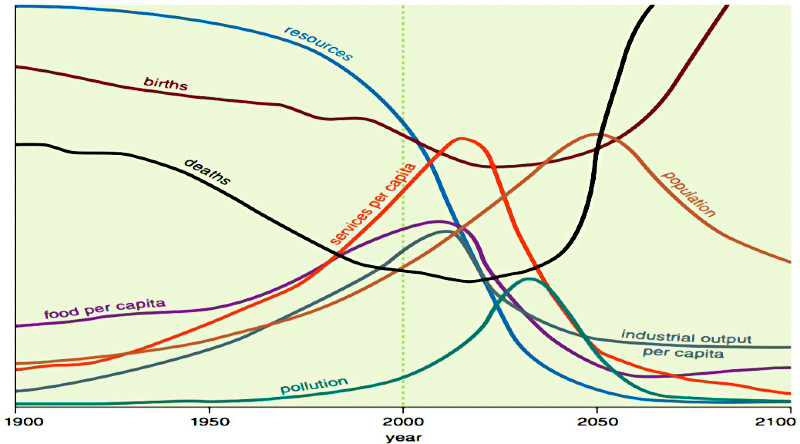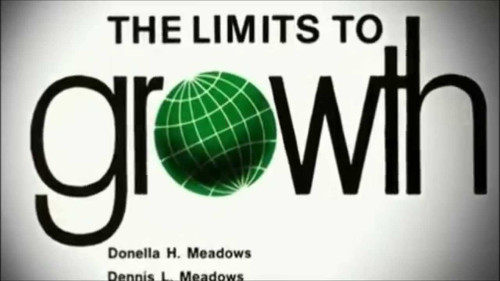The Club of Rome was formed in 1968. It included big shots and experts from 25 nations. Social and environmental challenges had grown beyond the ability of individual countries to manage. It was time to study the big issues, and develop strategies for dealing with them. Their research began with the Project on the Predicament of Mankind.
In 1972, Limits to Growth was published, authored by Donella Meadows, Jorgen Randers, and Dennis Meadows. (Here is a free PDF of the book.) They developed a computer model that allowed them to tinker with variables like population, food, pollution, and resources, and create possible scenarios for the coming decades. This allowed them to understand which variables were best for leveraging desired improvements.
The book concluded that we were on a path to big trouble, but it was not too late to avert disaster. World leaders did not leap to action, so 20 years later the second edition was published, Beyond the Limits. It announced that humankind was beyond overshoot, and it was time to slow down. Despite millions of copies sold, consumers kept consuming, and leaders kept snoozing. In 2004, the third edition was published, Limits to Growth — The 30-Year Update, the subject of this review.
All three books present two very important ideas. First, our planet is finite, so economic and population growth cannot continue forever. There are limits to growth. Nothing could be more obvious to anyone who has more than two brain cells, but our culture stubbornly refuses to accept this. It is impossible to ever have enough. We are hell-bent on perpetual growth, by any means necessary, at any cost. Sorry, kids! Even the most prestigious universities on Earth remain hotbeds of the perpetual growth cult, which is the equivalent of the flat Earth cult of centuries past.
Second, humans have moved beyond the limits. We are currently on a path that cannot continue for more than a generation or two. Sorry, kids! Exponential population growth continues, and exponential growth in resource consumption is growing even faster. Climate is becoming unstable. Cropland is being destroyed. Rivers and aquifers are being drained. Forests are vanishing. Fossil energy is finite. And so on. There are no silver bullet solutions, but there are countless ways to weaken the monster.
Naturally, the perpetual growth cult is yowling and screeching. They denounce the Limits to Growth research, asserting that the “predictions of the future” were wildly inaccurate, and therefore all of their ideas are pure balderdash. Of course, those who have actually read the book(s) know that the authors were careful to repeatedly remind readers that the various possible scenarios of the future were not predictions.
So, there are limits to growth, and we are beyond the limits — this begs the question: what next? The hurricane of predicaments that comprise humankind’s war on the planet is enormously complex. We have countless options, and the better ones include slowing down, consuming less, fewer kids. With regard to what next, the book gets fuzzier.
The intended audience is not the billion hungry souls living on less than two dollars a day. The authors are writing to the educated, wealthy elite — folks who will yowl and screech if anyone makes a move toward their air conditioner, refrigerator, or vehicle. They cannot wrap their heads around the notion that life can be both pleasant and sustainable, because sustainability implies terrible sacrifice, an unbearable reduction of their precious high-status, high-waste standard of living.
Because this elite audience is jittery and spooked, the discussion becomes more acrobatic and dubious. For example, “A global transition to a sustainable society is probably possible without reductions in either population or industrial output.” Not all growth is bad. Poor folks need some growth so they can escape from poverty, and discover the magic of family planning.

Of the ten scenarios presented in the book, only one results in a sustainable future, which is inhabited by eight billion happy humans. This scenario includes the highest number of major changes. In it, “the system brings itself down below its limits, avoids an uncontrolled collapse, maintains its standard of living, and holds itself very close to equilibrium.”
Our predicaments have been accumulating for centuries. The Agricultural Revolution sharply disturbed our relationship with the family of life, and the Industrial Revolution greatly magnified these imbalances. Consequently, it’s time for the Sustainability Revolution. The book mentions three ways of contemplating sustainability.
Most well known is the Brundtland Report, which defines sustainable development as “…development that meets the needs of the present without compromising the ability of future generations to meet their own needs.” It fails to point out the huge difference between wants and needs. Needs are about the basic necessities for survival: food, clothing, and shelter. Consumers often perceive needs as everything money can buy.
Another approach is the Herman Daly Rules. (1) Renewable resources such as fish, soil, and groundwater must be used no faster than the rate at which they regenerate. (2) Nonrenewable resources such as minerals and fossil fuels must be used no faster than renewable substitutes for them can be put into place. (3) Pollution and wastes must be emitted no faster than natural systems can absorb them, recycle them, or render them harmless.
The Daly Rules are clearer, and they imply backing away from industrial society and traditional agriculture, which is rational and daunting. His second rule is perplexing. It’s OK to use energy and minerals to make solar panels, but what would we need electricity for? Rule two would seem to prohibit using energy and minerals to make computers or refrigerators, because they are not renewable, and they require the existence of a vast and unsustainable industrial society. Readers are warned that a sustainable society “would be almost unimaginably different from the one in which most people now live.”
The authors favor a third approach to sustainability, the Ecological Footprint model, which compares the impact of human activities to the planet’s carrying capacity. They calculated that humankind’s current footprint requires an area 1.2 times the Earth — we have exceeded the planet’s carrying capacity by twenty percent, and this is unsustainable. The footprint is defined as “the total area of productive land and water ecosystems required to produce the resources that the population consumes and assimilate the wastes that the population produces, wherever on Earth that land and water may be located.” The footprint model is vague and imprecise.
The scenarios in the book are based on measurable variables, like cropland area, industrial output, energy reserves, population, and so on. They do not include unknowns like war, floods, earthquakes, epidemics, and climate instability.
A serious weakness in their computer model is the assumptions used to project crop yields. Nine billion could be fed in 2100 if cropland area was not diminished, if food production doubled worldwide, if degraded land was restored, if erosion did not increase, if irrigation capacity did not diminish, and if there was adequate energy and fertilizer. These assumptions are impossible to take seriously. Agriculture is highly unsustainable already.
No book provides the solutions we wish for — a healthy future, with a high standard of living, quickly achieved via easy, painless changes. Limits to Growth is a classic, and it takes a unique approach to describing our predicaments, and evaluating responses to them. It’s nourishing brain food, easy to read, and a bit sugarcoated.
Meadows, Donella; Randers, Jorgen; and Meadows, Dennis, Limits to Growth — The 30-Year Update, Chelsea Green, White River Junction, Vermont, 2004.
Author
Richard Reese lives in Eugene, Oregon. His primary interest is ecological sustainability, and helping others learn about it. He is the author of What Is Sustainable, Sustainable or Bust, and Understanding Sustainability and is currently working on a new book titled Wild, Free & Happy. Reese' blog wildancestors.blogspot.com includes free access to reviews of more than 196 sustainability-related books by a variety of authors both contemporary and historical, plus a few dozen of his own rants. The blog is searchable by author, title, or topic.





